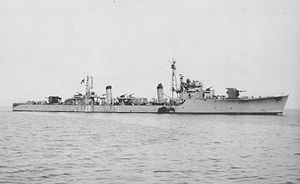Japanese destroyer Sakura (1944)
 Sister ship Momi, 4 September 1944
| |
| History | |
|---|---|
| Name | Sakura |
| Namesake | Cherry blossom |
| Builder | Yokosuka Naval Arsenal |
| Laid down | 2 June 1944 |
| Launched | 6 September 1944 |
| Completed | 25 November 1944 |
| Stricken | 10 August 1945 |
| Fate | Sunk by mine, 11 July 1945 |
| General characteristics (as built) | |
| Class and type | Matsu-class escort destroyer |
| Displacement | 1,282 t (1,262 long tons) (standard) |
| Length | 100 m (328 ft 1 in) ( o/a ) |
| Beam | 9.35 m (30 ft 8 in) |
| Draft | 3.3 m (10 ft 10 in) |
| Installed power | 2 × kW ) |
| Propulsion | 2 shafts, 2 × geared steam turbines |
| Speed | 27.8 knots (51.5 km/h; 32.0 mph) |
| Range | 4,680 nmi (8,670 km; 5,390 mi) at 16 knots (30 km/h; 18 mph) |
| Complement | 210 |
| Sensors and processing systems |
|
| Armament |
|
Sakura (桜 or 櫻, "cherry blossom") was one of 18 Matsu-class destroyers built for the Imperial Japanese Navy (IJN) during the final stages of World War II. Completed in late 1944, the ship was assigned to convoy escort duties in February 1945. She was slightly damaged when she struck a mine in May. Sakura sank after striking another mine near Osaka on 11 July with heavy loss of life.
Design and description
Designed for ease of production, the Matsu class was smaller, slower and more lightly armed than previous destroyers as the IJN intended them for second-line duties like escorting convoys, releasing the larger ships for missions with the fleet.
The main armament of the Matsu-class ships consisted of three
Construction and career
Authorized in the late 1942
Sakura was slightly damaged when she struck a mine in
References
Bibliography
- Jentschura, Hansgeorg; Jung, Dieter & Mickel, Peter (1977). Warships of the Imperial Japanese Navy, 1869–1945. Annapolis, Maryland: United States Naval Institute. ISBN 0-87021-893-X.
- Nevitt, Allyn D. (1998). "IJN Sakura: Tabular Record of Movement". www.combinedfleet.com. Retrieved 21 September 2020.
- Stille, Mark (2013). Imperial Japanese Navy Destroyers 1919–45 (2): Asahio to Tachibana Classes. Botley, UK: Osprey Publishing. ISBN 978-1-84908-987-6.
- Sturton, Ian (1980). "Japan". In Chesneau, Roger (ed.). Conway's All the World's Fighting Ships 1922–1946. Greenwich, UK: Conway Maritime Press. ISBN 0-85177-146-7.
- ISBN 0-87021-326-1.
